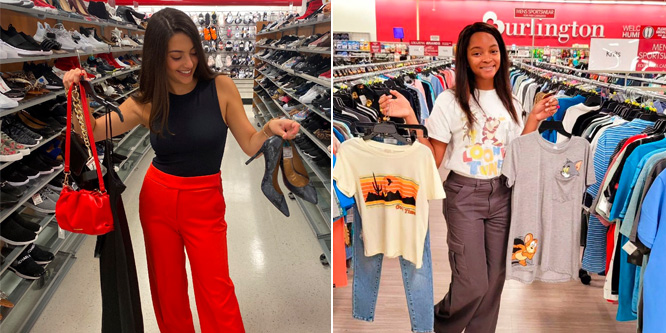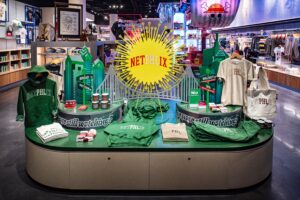
Photos: Facebook/@tjmaxx; @BurlingtonStores
March 9, 2022
Will inflation be positive or negative for off-pricers?
Michael O’Sullivan, CEO at Burlington Stores, believes surging inflation may drive consumers to trade down to off-pricers, but it may also squeeze spending.
“It’s not hard to articulate the risk,” said Mr. O’Sullivan when asked about inflation last week on his company’s fourth-quarter analyst call. “In the coming months, it’s possible that consumers and especially, low-income consumers … will be squeezed as we lap stimulus payments. And at the same time, general price inflation begins to bite, especially on sort of the central items like food and gas.”
A possible offset, he noted, is that lower-wage workers have been seeing strong wage gains amid a labor shortage to possibly mitigate inflationary pressures.
The “big opportunity,” he said, is that during uncertain economic times, consumers’ “natural and rational reaction” is to seek out value.
“Higher inflation affects everybody,” said Mr. O’Sullivan. “As a value leader at Burlington, we should be well positioned in that situation, and we think we might benefit from a trade-down customer.”
Michael Hartshorn, Ross Stores’ COO, noted that with U.S. inflation recently hitting a 40-year high, “we don’t have a ton of experience on how the customer will react.”
He said on a quarterly call last week, “So I’d be speculating as inflation appears at this point to be with us for a while. In general, I’d say the consumer seems to be healthy coming into the year, given higher wages and savings. But obviously, with this level of inflation throughout the economy, they’re going to have to make choices how and where they spend their money, and it’s highly likely the consumer will be seeking value, and that would be positive for us.”
Ernie Herrman, TJX’s CEO, said higher prices across retail are enabling TJX to “get even more aggressive about adjusting our retails” to help offset freight and wage pressures. But he also believes consumers would trade down to save money. Mr. Herrman told analysts, “Anytime there’s uneasiness, I would say, it’s just a great opportunity for our model to accelerate a little bit more.”
- Burlington Stores, Inc. Reports Fourth Quarter 2021 Results – Burlington Stores
- Burlington Stores’ (BURL) CEO Michael O’Sullivan on Q4 2021 Results – Earnings Call Transcript – Seeking Alpha
- Inflation is high, but wage gains for low-income workers are higher. For now – Fortune
- Ross Stores Reports Fourth Quarter And Fiscal 2021 Results And Provides First Quarter And Fiscal 2022 Outlook – Ross Stores
- Ross Stores, Inc. (ROST) Q4 2021 Earnings Call Transcript – Alpha Street
- The TJX Companies, Inc. Reports Very Strong U.S. Open-Only Comp Store Sales Growth Of 13% For Q4 FY22 Vs. Q4 FY20; FY22 U.S. Open-Only Comp Sales Up 17% Vs. FY20; Announces Plans To Increase Dividend 13% And Buy Back $2.25 To $2.50 Billion Of Stock – The TJX Companies
- The TJX Companies, Inc. (TJX) CEO Ernie Herrman on Q4 2022 Results – Earnings Call Transcript – Seeking Alpha
Discussion Questions
DISCUSSION QUESTIONS: Will surging inflationary pressures likely offer more of a benefit or drawback for off-pricers? Do you see product availability, the promotional climate or some other factor having the biggest impact on the channel over the next year?
Poll
BrainTrust
Gary Sankary
Retail Industry Strategy, Esri
Doug Garnett
President, Protonik
Kenneth Leung
Retail and Customer Experience Expert
Recent Discussions







We are past stimulus payments and past pent up demand. But we have an improving unemployment situation and rising wages. This has to be one of the most complicated moments in recent history. Too complicated for me to make a call one way or the other. Too many variables on how bad the inflation will get or how long it will last. Unfortunately, things could get a lot worse before they get better.
With inflation at historic levels, one can only assume that shoppers are going to be looking to make their dollars stretch and shopping off-price can certainly help. So off-pricers should do well in this climate. That said, product availability continues to be a challenge in some categories and this may create a head wind.
And if I’m a brand, where am I going to send new inventory? Probably where I can get the highest price. Even if I’m a manufacturing plant overseas, which order am I going to prioritize? If I were at TJX or Burlington, I’d really be looking hard at vertical integration to secure my supply lines at a consistent cost. That would also require creating in-house design (or at least licensing) expertise, so it’s not without risk – but product availability is a much bigger risk.
Inflation has been an issue for consumers over the past six months or so, and up until now it doesn’t appear to have dented their appetite for spending. But the surge in gas prices is another story, because it will affect discretionary spending like nothing else. (Even more so if prices rise for natural gas and home heating oil.) The question is whether shoppers — who have underspent during the pandemic — will trade down or stay home; my bet is on trading down because pent-up demand is still high.
Inflation is broadly positive for off-price as it makes consumers more budget conscious and more likely to seek bargains. In our consumer tracking, we have already seem a move into off-price by consumers who are concerned about rising costs. That said, off-price is not immune to inflation and if households become very squeezed they will likely reduce the volume of discretionary purchases which can have a negative impact. Of course, we are not used to a highly inflationary environment – at least not over the past few decades or so – so there is no real precedent for how this will play out.
Inflation will push bargain hunters toward off-pricers. The challenge will be to keep them once inflation goes away. Yes, I believe off-price retail will thrive in these inflationary times as the high-end customer seeking value will more than make up for the shortfall among traditional off-price consumers. I even believe that the traditional customer will still shop but aim more at the markdowns, as who doesn’t like a “bah-gin”!
It will be tempting to some off-pricers to crank up the “retail” price to appear to be discounting even further. The other temptation will be to blame inflation for all upward pricing changes. We shall see.
Any time consumers’ budgets are squeezed, they’re going to start looking down market for alternatives to save money.
Totally agree, however key categories for OPRs (off-price retailers) tend to be those that are discretionary spending, like apparel and home fashions. Price pressures I feel drive customers more to mass-merchants and dollar stores, while discretionary spending also gets reduced. There’s a lot of pressures right now, so it will be interesting to see.
Inflation will most definitely benefit off-pricers. As it continues to climb due to domestic/international dynamics and policies, I think we’re in for a wild ride in 2022. Product availability will definitely be an issue which will exacerbate already fragile supply chains, and I could see an anxious promotional climate, with manufacturers and retailers being extremely judicious in how they allocate big dollars for programs.
The OPRs (off-price retailers) have already announced plans to raise pricing this year, so I don’t anticipate this price gap to be significant enough to drive traffic. Brand offering in my opinion is the biggest area of competition facing the market right now. Yes, supply chain is a challenge, but all majors are working to cement themselves as a destination for either national brands, private brands, or a mix. OPRs typically position themselves against major department stores as a destination for name brands, however now that competition has increased as retailers like Walmart, Kohl’s, and even Big Lots seek to expand their portfolios.
Every tank fill up that costs double will pinch budgets and drive discretionary spending down and/or shift to lower priced options for lower to middle class shoppers. This is the natural evolution of supply/demand and price elasticity.
The off-price market traditionally does well when consumer buying power is constricted. Not only do off-price retailers see an increase in customers, but the quality of the products they offer will also improve since their purchasing power for stock also improves as other markets pull back, which in turn further increases their customer appeal.
The most resilient sectors of our retail economy are at the opposite sides of the pendulum. Both the off-price and luxury sectors are the most resilient, adaptable, and in any way both inflation and recession-proof. The off-price sector was built for this moment. Especially given that there have been so many delays, supply chain disruptions and the traditional operating model of the merchandising cycle has been impacted. There will be plenty of excess inventory and opportunities for the off-price sector to exploit to grow during the inflationary period.
We should expect the middle of the retail spectrum, the department stores, specialty stores, and others to face plenty of challenges, as consumers become more price-conscious and deliberate with their spending. The “thrill of the hunt” and the value that off-price brands offer are very appealing, especially when consumers have less discretionary spending.
Off-pricers are likely to benefit. When the 2008 recession hit, we learned that people don’t stop spending – they spend differently. So at home stores while contractor projects shrank, DIY projects grew. I expect to see a similar reaction here. After all, the kids still need clothing.
As consumers’ budgets are stretched, they’ll flock to the off-pricers. But the off-pricers will only be able to hold them if they focus on providing a simpler customer experience. Price alone won’t keep the consumers there when (if?) inflation stabilizes.
Even if prices go up for the discount/off-pricers, they will still be less expensive than traditional retailers. Consumers will feel squeezed due to inflation and other issues impacting their pocketbooks. This is the opportunity for the discount stores to thrive.
For those shoppers who read the headlines about inflation, they will automatically start thinking of off-price outlets. The reality is apparel inflation has been minimal. According to WWD, men’s apparel prices gained 2.6 percent over the two years while women’s apparel prices fell 0.9 percent.
The “lipstick” factor is in full force whereby you can identify depressed purchasing power by the rise in lipstick sales (in theory). Consumers want to consume and will trade down as their budgets allow. This will definitely benefit off-price retailers, as it will fast food and generic/owned brands who provide more value.
It is true that wages have increased since the pandemic as labor shortages have hit the lower paid jobs, but the level of inflation we are now seeing and are expecting will soon erode those increases. In hard times people do trade down, especially on clothing, sports goods, etc., where they still want a treat but do not have the money for full price brands. In food retail, it is usually a time when own-label gets a push and does well, so retailers that have strong own-label products at good value prices will do well. The emphasis is more on value than cheap, as consumers still want value for money and not something that is not worth having. This can be a really good time to build loyalty and get people to try own-label products that will keep them loyal to your stores after this has passed, which may not be any time soon.
Inflation benefits those with the ability to take on debt so the broad base of affluent shoppers aren’t going to trade down right away. For those living paycheck to paycheck, inflation is a serious setback. Yesterday, the national average cost for a gallon of gas hit a historic high. If it continues to rise to say $4.50 or more all brick-and-mortar retailers — with the exception of luxury goods stores – – are going to take a hit. At that point discounters may see a surge, but I’d look very closely at shifts to online shopping. As to looking forward across the year, I still think the price of gas is the single most critical factor.
As budgets get tighter, consumers will definitely migrate their shopping decisions, but it won’t be a “one size fits all” and it will be very important for off-pricers and other discounters to monitor how and where those demand shifts are occurring. It will also be relevant for non-discounters to continue to offer better prices on key items to prevent customer leakage at a time when inflation is high, competition is higher than ever and brand loyalty is at an all time low.
Now is also the time for all retailers to realize the full potential of their own ‘off-pricer’ brands and build effective, analytics informed strategies to grow their private label offerings while consumers are looking for alternatives. Inflation has a lot of potential to shift share — there will be winners and losers for sure.
Inflation is driving up the cost of goods and transportation also. I do wonder if off-pricers will be able to source the goods to keep their margins. Certainly, consumers will always seek out value during inflation, but will manufacturers will limited production and delivery capacity focus on low priced items?
They have to have inventory to sell inventory. I think supply chains are still a bit tight.
Also the Russia situation and its potential impacts may come into play here too. I am not clear where China stands on the Russia situation, but it is a major supplier of goods to the clothing and home sector in the US and in Russia. Who knows how tangled up this mess could get.
Also we remember what it was like in summer 2008 when gas got this high. The economy hit a standstill.
The discounters seems to do well in both good economies and bad ones. I think fundamentally, everybody likes a bargain and likes to feel like they are “winning” when they shop!
Certain inflationary pressures, such as the dramatically increase in price of gasoline, or the change in the price of staple goods at the grocery store, tend to trigger consumers to become more conservative with their spending. That will lead certain segments of consumers to postpone or forgo purchases and others to seek out discount brands. However, inflation will be most strongly felt in staple items, where private label products have been available for a long time — the immediate trade-off across other categories is more uncertain. I believe that the Ukrainian war will play an even bigger role in the short term in driving consumer uncertainty than short term inflation pressures. The impact of that uncertainty will be for consumers to postpone high ticket item purchases.
Spring and Summer may be less inflation-weary as consumers get back to rare moments of lounging and relaxing with family and friends while feeling relatively safe doing so.
However, Fall and back-to-school will show the real impact of inflation and consumers making tough calls to keep kids happy. Off-pricers stand to gain ground during that time. In the meantime, it’s a good idea to increase awareness and establish familiarity before Fall, so off-price brands are top of mind when inflation-reality bites.
I think the increase in inflationary pressures will benefit the off-pricers. Increased inflation means customers have disposable income to spend. Retailers leverage this situation to increase their prices marginally, thereby upsetting a larger segment of customers. Off-pricers here can grab the opportunity to tap those customers who are dissatisfied with the price hike and retain them by delivering superior customer experiences.
Speaking of factors determining the performance of the channel, digital initiatives and product availability will have a significant impact. Customers who walk into stores would expect a larger assortment of products in abundant quantities. Secondly, off-pricers would need to ensure that they are catering to digitally-savvy consumers accurately. These retailers should implement omnichannel initiatives like BOPIS and curbside pickup and boost a deeper level of interaction with customers.